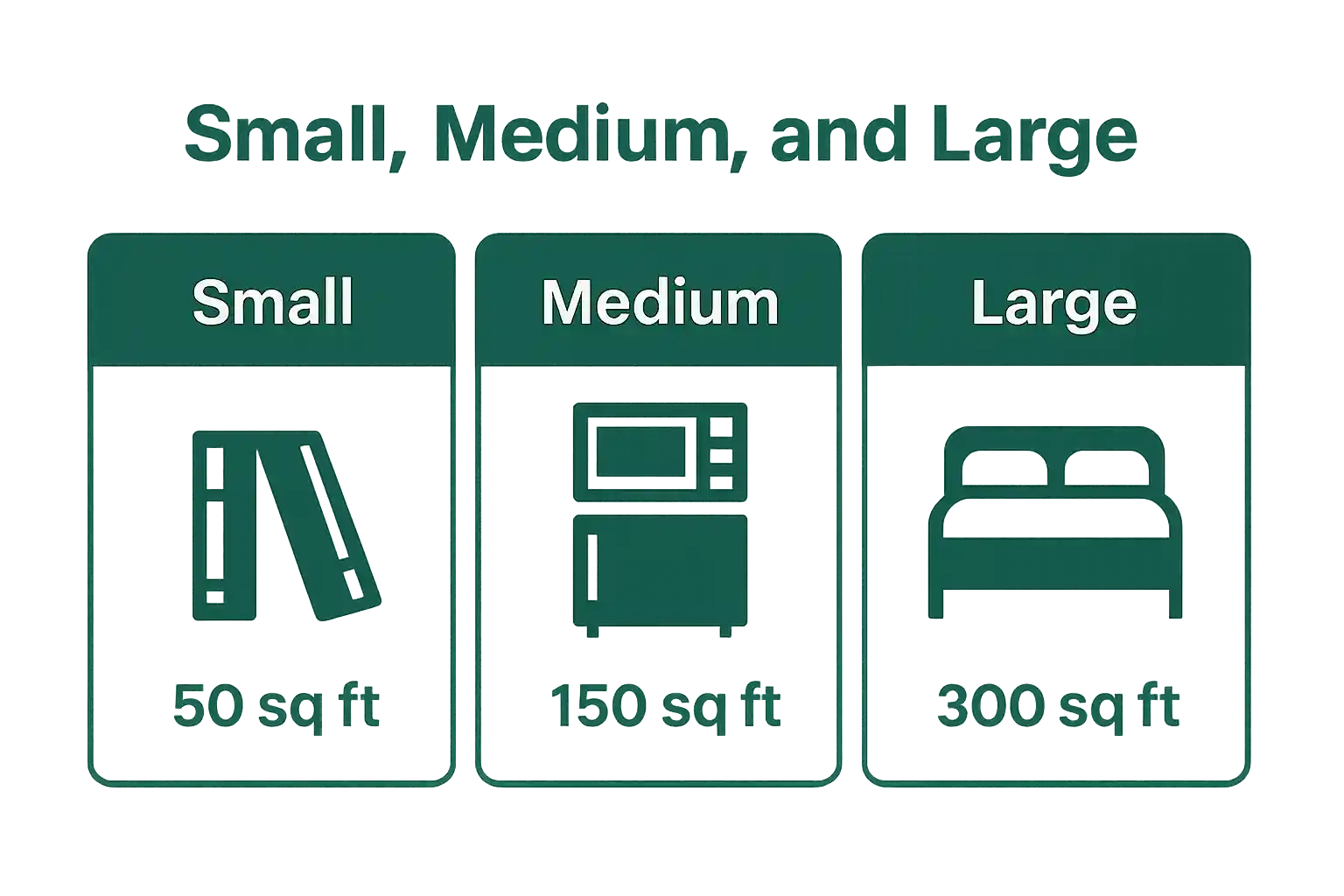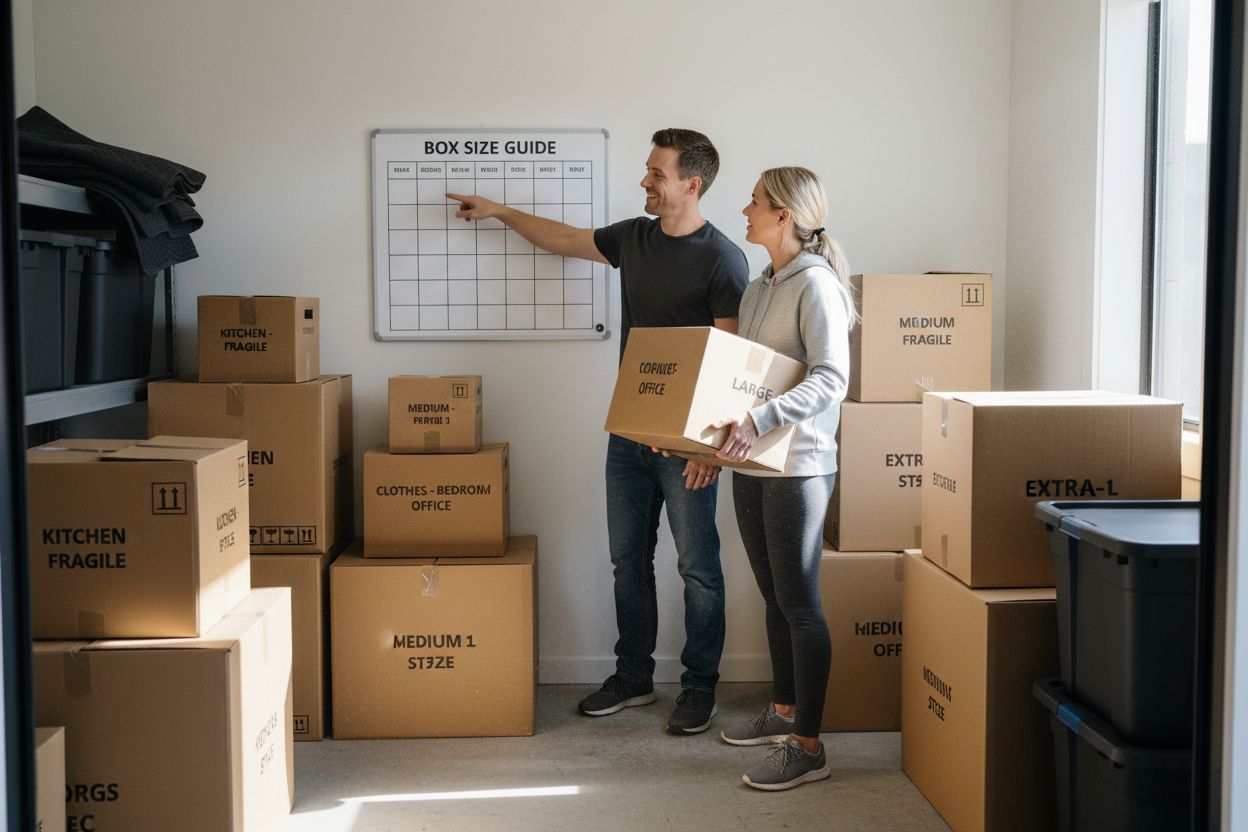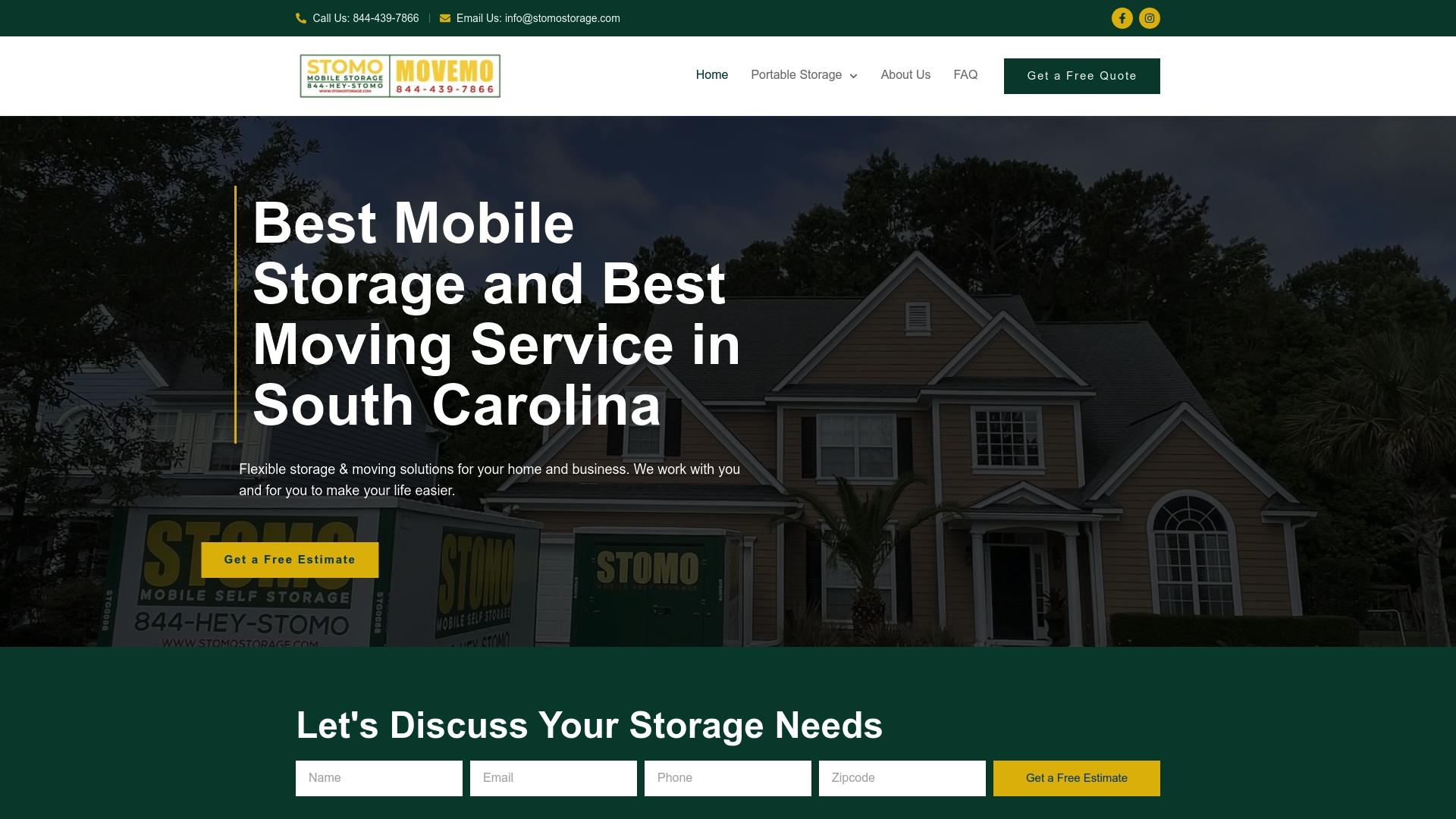Picking the right moving box seems simple enough, right? Most of us just grab whatever boxes we can find and call it a day. But here’s the thing, using the wrong box can actually lead to damaged belongings and cost you way more time and money than you’d expect. Professional movers see it all the time: matching your box size to what you’re packing matters way more than most people realize. In fact, it’s one of the biggest reasons moves end up being way more stressful than they need to be.
Table of Contents
Quick Summary
| Takeaway | Explanation |
| Choose the right box size | Selecting the appropriate box size can prevent damage and improve efficiency during your move. |
| Utilize specialized boxes | Specialized boxes provide extra protection for delicate or unique items, ensuring safe transport. |
| Optimize packing efficiency | Proper box size enhances space utilization, reduces weight distribution issues, and prevents item movement. |
| Consider cost implications | Using the right box size minimizes transportation costs and labor expenses by maximizing space and reducing trips. |
| Understand structural integrity | Different boxes have varying load capacities; knowing this aids in selecting the right box for each item. |
What Are Moving Boxes and Their Sizes?
Moving boxes are specialized containers designed to safely pack, transport, and store personal belongings during relocation or storage. Understanding the right moving box size and type can significantly streamline your moving or storage process, preventing potential damage and maximizing space efficiency.
Understanding Basic Moving Box Dimensions
Moving boxes come in standard sizes that cater to different household items and storage needs. Research from professional moving organizations reveals three primary box categories:
-
Small Boxes (1.5 cubic feet): Ideal for heavy items like books, kitchenware, tools, and small electronics
-
Medium Boxes (3 cubic feet): Perfect for kitchen appliances, decor items, pantry goods, and miscellaneous household objects
-
Large Boxes (4.5 cubic feet): Best for lightweight, bulky items such as bedding, pillows, stuffed animals, and clothing
Specialty Boxes for Specific Needs
Beyond standard sizes, specialized moving boxes exist for unique items requiring extra protection. Wardrobe boxes with built-in hanging rods protect clothing, while dish pack boxes feature cellular dividers to prevent glassware and fragile kitchenware from breaking during transit.
Selecting appropriate box sizes isn’t just about fitting items—it’s about ensuring safe transportation. Overloading small boxes with heavy items can lead to structural failure, while underpacking large boxes wastes space and creates potential shifting during movement.
Learn more about our smart packing tips for moving to maximize your moving efficiency and protect your belongings. Understanding box sizes is the first step in creating a strategic, organized moving plan that saves time, reduces stress, and keeps your possessions secure.
Here is a comparison of standard moving box sizes, their typical dimensions, and common uses to help you select the best option for your move.
| Box Size | Approximate Volume (cu ft) | Typical Dimensions (inches) | Best For |
| Small | 1.5 | 16 x 12 x 12 | Books, kitchenware, tools, small electronics |
| Medium | 3.0 | 18 x 18 x 16 | Pantry goods, decor, kitchen appliances, misc items |
| Large | 4.5 | 24 x 18 x 18 | Bedding, pillows, stuffed animals, lightweight items |
| Wardrobe | Varies | 24 x 24 x 40 | Hanging clothes, bulky garments |
| Dish Pack | Varies | 18 x 18 x 28 | Fragile glassware, dishes, china |

Why Choosing the Right Box Size Matters
Selecting the appropriate moving box size is far more than a simple organizational task—it’s a critical strategy that impacts the safety, efficiency, and cost-effectiveness of your moving or storage experience. Professional movers and logistics experts emphasize that box selection directly influences the protection of your belongings and the overall moving process.
This table breaks down key risks and consequences associated with incorrect moving box sizing to emphasize why proper selection matters.
| Incorrect Box Sizing | Potential Risk or Consequence | Explanation |
| Overloading small box | Structural compromise (bottom blowout) | Too much weight can cause the box to break or fail |
| Oversized for delicate items | Increased item fragility | Extra movement can lead to breakage of fragile contents |
| Insufficient padding | Higher chance of damage during transit | Inadequate cushioning increases the risk of items getting damaged |
| Underpacking large box | Wasted space, shifting contents | Unfilled spaces allow items to move, increasing damage risk |
| Improper packing | Handling difficulties | Awkward or heavy boxes are hard to lift or stack safely |
Preventing Potential Damage and Structural Risks
Research from moving industry experts reveals that inappropriate box sizing leads to significant risks. Overloading small boxes with heavy items increases the likelihood of structural failure, while using oversized boxes for delicate items creates unnecessary movement and potential breakage. Proper box selection acts as a first line of defense against potential damage.
Key risks of incorrect box sizing include:
-
Structural Compromise: Heavy items in small boxes can cause bottom blowout
-
Item Fragility: Insufficient padding and inappropriate box size increases breakage potential
-
Handling Difficulties: Improperly packed boxes make lifting and transport more challenging
Economic and Efficiency Considerations
Beyond physical protection, selecting the right box size has direct economic implications. Inefficient packing means more boxes, higher transportation costs, and increased labor expenses. Professional moving strategists recommend matching box size precisely to contents, which minimizes wasted space and reduces overall moving expenses.
Check out our comprehensive storage unit guide to understand how strategic sizing impacts your entire moving strategy. Smart box selection isn’t just about fitting items—it’s about creating a systematic, cost-effective approach to relocation that protects your investments and simplifies your moving experience.
How Moving Box Sizes Affect Packing Efficiency
Packing efficiency is a nuanced art that goes far beyond simply fitting items into containers. The strategic selection of moving box sizes plays a pivotal role in transforming a potentially chaotic moving experience into a streamlined, organized process. Understanding how different box dimensions impact overall packing performance can significantly reduce time, effort, and potential damage during relocation.
Strategic Box Size Optimization
Professional moving logistics research demonstrates that precise box sizing directly correlates with packing efficiency. Efficient packers recognize that not all items require the same container volume, and matching box size to contents is crucial for maximizing space utilization and minimizing potential movement during transport.
Key efficiency considerations include:
-
Vertical Space Management: Choosing appropriate box heights allows for optimal stacking and storage
-
Weight Distribution: Matching box size to item weight prevents structural compromise
-
Compact Loading: Selecting correctly sized boxes reduces empty spaces in moving vehicles
Space Utilization and Transport Economics
Box size directly influences the number of trips required and overall transportation costs. Compact, well-planned packing reduces the total volume of space needed, which translates to potential savings in moving truck rental or shipping expenses. Smaller, appropriately sized boxes enable more precise loading, reducing the risk of items shifting and potentially preventing damage during transit.
Explore our comprehensive moving efficiency guide to learn advanced strategies for maximizing your packing potential. The right box size is more than a container—it’s a critical tool in creating a smooth, efficient moving experience that protects your belongings and simplifies your relocation process.
Key Concepts Behind Box Sizing and Usage
Moving box selection is a sophisticated process that extends far beyond simply choosing a container. Professional movers understand that box sizing involves complex considerations of structural integrity, content protection, and logistical efficiency. Understanding these nuanced principles transforms packing from a mundane task into a strategic operation.
Structural Integrity and Load Capacity
Research from moving industry experts reveals that each moving box possesses unique load-bearing characteristics. Box strength depends on multiple factors including cardboard thickness, construction method, and manufacturing quality. Not all boxes are created equal, and recognizing these differences is crucial for safe transportation.
Key structural considerations include:
-
Material Composition: Corrugated cardboard with multiple layers provides superior strength
-
Edge Crush Test (ECT) Ratings: Indicates maximum vertical compression a box can withstand
-
Weight Distribution: Balanced loading prevents potential structural failure
Functional Design and Purpose-Specific Applications
Moving boxes are engineered with specific use cases in mind. Specialized designs cater to unique items, offering enhanced protection and organizational efficiency. Matching box design to content requirements minimizes potential damage and maximizes packing effectiveness.
Explore our comprehensive storage unit packing guide to understand how strategic box selection impacts your entire moving strategy. By comprehending these fundamental concepts, you transform box selection from a simple procurement task into a sophisticated approach to protecting and transporting your valuable belongings.
Real-World Applications of Moving Box Sizes
Moving box sizes transcend theoretical discussions, offering practical solutions across diverse scenarios. From residential relocations to specialized industry needs, strategic box selection becomes a critical component of efficient logistics and asset management. Understanding real-world applications helps individuals and professionals optimize their packing and storage strategies.
Residential and Personal Moving Scenarios
Moving industry research indicates that residential moving presents complex challenges requiring nuanced box sizing approaches. Different household areas demand specialized container selections to ensure safe transportation and efficient space utilization.
Typical residential moving box applications include:
-
Kitchen Moves: Medium boxes with reinforced bottoms for small appliances and kitchenware
-
Bedroom Transitions: Large boxes for bedding, clothing, and lightweight items
-
Home Office Relocations: Small, heavy-duty boxes for books, electronics, and sensitive documents
Commercial and Specialized Industry Usage
Beyond personal moving, professional sectors leverage precise box sizing for inventory management, equipment transportation, and archival storage. Specialized industries require custom box solutions that protect valuable assets while maximizing logistical efficiency. Construction companies, medical facilities, and technology firms rely on strategic box selection to maintain organizational integrity during transitions.
Discover our expert storage unit packing strategies to understand how professional-grade box sizing transforms complex moving and storage challenges. By recognizing the multifaceted applications of moving box sizes, you unlock a sophisticated approach to protecting and managing your most valuable resources.

Make Moving Easier With the Right Box and the Right Team
Struggling to figure out which box size really fits your needs or worried about what happens if you misjudge during your next move? The article highlighted just how important it is to match your belongings to the perfect moving box. Overpacking, wasted space, and fragile items at risk are common pain points that can turn what should be a simple move into a stressful nightmare. You deserve a moving and storage solution where you never have to wonder if your valuables are truly protected. Explore our Moving Services designed to streamline your entire experience. Our local team helps with not just packing advice but also provides flat-rate, concierge-style moving, ensuring both your box sizing and logistics are handled from start to finish.

Why risk box-related hassle or overspending with big national chains? Choose STOMO Mobile Storage to get family-owned service, flexible mobile storage delivery, and detailed guidance tailored specifically to South Carolina residents. See how easy and affordable moving can be when you trust a team that truly understands local needs—check out our Storage Solutions or connect with us now for a seamless, personalized plan that starts with your very first box.
Frequently Asked Questions
What are the standard sizes of moving boxes?
Moving boxes typically come in three standard sizes: small (1.5 cubic feet), medium (3 cubic feet), and large (4.5 cubic feet). Small boxes are ideal for heavy items, medium boxes suit kitchen appliances and decor, while large boxes accommodate lightweight, bulky items.
Why is it important to choose the right moving box size?
Choosing the correct moving box size is essential for ensuring the protection of your belongings, preventing structural failure, and maximizing packing efficiency. Incorrect sizing can lead to damage, inefficient transport, and higher moving costs.
How do specialty moving boxes differ from standard boxes?
Specialty moving boxes, such as wardrobe boxes and dish pack boxes, are designed for specific items requiring extra protection. They often feature unique designs, like hanging rods or cellular dividers, to safeguard delicate or bulky contents during transit.
What are the consequences of overloaded or underpacked moving boxes?
Overloaded boxes can experience bottom blowout or structural failure, while underpacked boxes can lead to wasted space and items shifting during transport, increasing the likelihood of damage. Proper box selection and packing strategy are crucial to preventing these issues.
